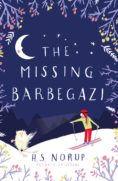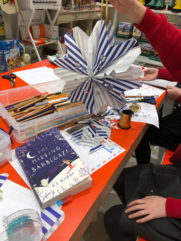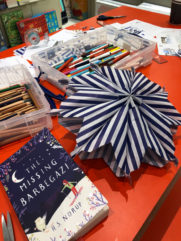The Missing Barbegazi
 By H S Norup
By H S Norup
Tessa believes that barbegazi exist and has absorbed all the details from her late grandfather’s stories about seeing them . Her family and her friends are however more inclined to dismiss him as a confused old man. Distracted from her preparations for a skiing competition by her hunt for a barbegazi, Tessa falls into a hidden hollow under the snow and is rescued by Gawion, a barbegazi anxiously looking for his missing twin sister. The rest of the story focuses on whether Tessa and Gawion can build the trust to work together to rescue his sister, Maeg.
There are a lot of other things going on at the same time. Tessa’s grandfather has recently died and she and her family are grieving for him. Adding to her worries, Tessa’s grandmother is ill and she is increasingly distanced from her friends who tease her about her search for the barbegazi and have formed new alliances while her focus has been elsewhere. Although Gawion is 154 years old, he is still a teenager in barbegazi terms and because of their fear of humans, he lives an isolated life with his twin as his only friend. Both Tessa and Gawion have to learn how to take risks and believe in themselves but also win the trust of those closest to them. This manages to give some quite different perspectives on growing up, intergenerational relationships and friendships, all while the mystery of where Maeg has gone unravels at a fast pace.
Set between Boxing Day and New Year’s Eve, The Missing Barbegazi is well suited as a snowy winter read over Christmas. The author’s love of the outdoors, the mountains and skiing certainly comes through and this is an impressive first book. It is recommended for Year 5s and up (and possibly very confident Year 4s). Some of the vocabulary is quite challenging and at 250 pages long, readers need to have developed a degree of stamina. That said, the structure of the book breaks up what is quite a complex story into manageable parts – it is told through the dual perspectives of Tessa and Gawion, plus added extracts from “A Historic Account of Alpine Elves” set out in a non-fiction style. This approach also lends itself to discussion of techniques children might use in their own writing. Other areas for discussion include how and why authors use personification and anthropomorphism; and links to examples of mythical creatures from different parts of the world – barbegazi are found in stories from the Swiss and French Alps with the name coming from the French for beard (barbe) and frozen (glacée).
The author’s own website has some more information about her background and there is an interesting interview about the book here. Norup also has a Pinterest page used as inspiration for the book.
Book Club members (Y5&6) were enthusiastic about the book – they liked the adventure and pace. They thought having the chapters coming from different perspectives worked well (although there was disagreement about whether Professor Bahne should have had his own chapters). Tessa was seen as determined and persistent and some of the friendship issues clearly rang true for them. We solved Tessa’s crossword clues for Oma and made large paper snowflakes.


